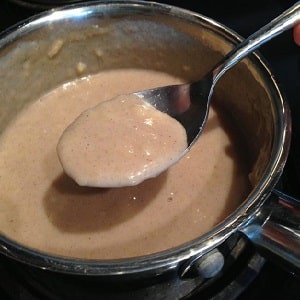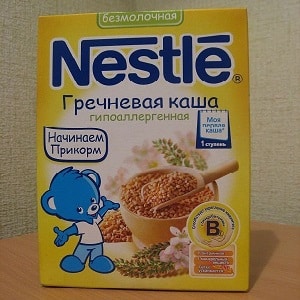How to prepare buckwheat porridge for first feeding
Immediately after the birth of a child and during the first year of life, it is important to properly organize his nutrition. After all, the baby’s activity, development and growth depend on this. Special requirements are put forward for products and their quantities, since the capabilities of the child’s digestive system are still limited.
Moms always have a lot of questions about how to properly introduce supplementary feeding, what foods to give and when. Our article will answer in detail the question, is it possible to use buckwheat porridge for the first feeding?
When to start feeding cereals
When and how to introduce porridge into a newborn’s diet depends on what the baby eats. If he is on artificial or mixed feeding, then The first supplementary feeding is introduced a little earlier, since the enzymatic systems in such children are more developed. This age is about 5.5-6 months.
For infants under 6 months of age, any food other than breast milk or its substitutes will not only not be beneficial, but will also be more likely to cause harm.

From what age
The child receives additional feeding from 6 months. Vegetables are the first to be introduced into the diet. From 7 months, porridge appears on the baby’s menu: buckwheat, corn, rice. They are safer for the baby's health, as they do not contain gluten, which causes small intestinal disease (celiac disease).
Children who do not gain weight well, have problems with bowel movements, and are prone to regurgitation, the pediatrician may recommend starting complementary feeding with gluten-free cereals, which include buckwheat. Porridges should be dairy-free. Milk is allowed to be introduced into the diet after one year.
Rules for introducing buckwheat into a baby’s diet
There are certain recommendations regarding when to start and how to properly introduce buckwheat into your diet:
 Supplemental feeding with buckwheat is started if the baby is not going to be vaccinated in the near future.
Supplemental feeding with buckwheat is started if the baby is not going to be vaccinated in the near future.- If a child is restless or feels unwell, it is advisable to consult a pediatrician before introducing him to a new product, including buckwheat. You may need to have your blood tested.
- It is best to offer buckwheat to your baby on an empty stomach to determine the body’s reaction to such food.
- Porridge should not be stored; the child receives only freshly prepared food.
- No spices, salt or sugar are added to the porridge.
- If a baby refuses to eat buckwheat porridge, there is no need to force him, since taste habits are formed already in the first year of life.
- If you are allergic to buckwheat, it must be excluded from the diet and reintroduced no earlier than after 2 months.
- It is not recommended to give your child several new types of food at once.
Nevertheless, it is better to consult with a pediatrician about the exact age at which you should start giving buckwheat, in what quantity, and how to prepare buckwheat for feeding your baby.
It can be useful:
Is it possible to eat buckwheat with pancreatitis?
The benefits of eating buckwheat with kefir on an empty stomach in the morning
In what form to give
 In what form to offer buckwheat to the baby depends on the preferences of the parents. Convenient to use ready-made dairy-free cereals, which are simply diluted with water.Better yet, cook the porridge yourself at home. The main thing is that the food is soft and of uniform consistency.
In what form to offer buckwheat to the baby depends on the preferences of the parents. Convenient to use ready-made dairy-free cereals, which are simply diluted with water.Better yet, cook the porridge yourself at home. The main thing is that the food is soft and of uniform consistency.
For the first feeding, the porridge should be liquid, 5%. This means for 100 ml of water you will need 5 g of buckwheat flour. An older baby can already be fed with thicker porridge - 8-10%.
In what quantity
Buckwheat porridge should be given to the child with half a teaspoon daily.. In the absence of allergic manifestations and other negative reactions from the digestive system, gradually over the course of a week the volume of food is increased to 100-150 g, replacing one feeding.
Advice. Buckwheat is introduced into the children's diet gradually, each time monitoring the baby's condition, because allergies can appear after the volume of cereal has been significantly increased.
Recipes for buckwheat dairy-free porridge for first feeding
The most useful for the body are kernels - whole grains, peeled from the surface shell.. You can also prepare porridge from buckwheat flour or Smolensk buckwheat (peeled and finely ground grains). However, both products are inferior in nutritional and beneficial properties to the kernel.
How to cook buckwheat for babies on water:
- Sort the kernels, rinse until clear water, and dry.
- Transfer the grains to a blender or coffee grinder and grind to flour.
- 1 tsp. buckwheat flour pour 100 ml of purified water, after boiling, cook for 15-20 minutes. Cool to room temperature.

For a one-year-old child and older children, replace water with low-fat milk. Pediatricians do not recommend eating milk porridge for babies under one year old, as they negatively affect the mucous membrane of the digestive tract and increase the risk of gastrointestinal diseases.
For reference. How long to cook ground buckwheat for a child? The time depends on the type of cereal and the degree of grinding of the grain. On average, it is enough to simmer the porridge over low heat under the lid for 15-25 minutes, stirring occasionally.
How to grind
Grind buckwheat (kernel) or ready-made porridge.
In the first case The algorithm of actions is as follows:
- Sort the grains, clean them from foreign impurities.
- Rinse well, strain off excess water through a colander, and dry the cereal.
- Next, using a blender or coffee grinder, grind the grains to flour.
 How to cook buckwheat for babies:
How to cook buckwheat for babies:
- Dry quality cereal in the oven until it turns golden brown.
- Pour the grains with water in proportions 1:2, boil until tender for 15-20 minutes, cool.
- Place the warm porridge in a blender and grind well. Add water, adapted formula or breast milk to the desired consistency.
It is convenient to use a sieve as a kitchen utensil.. To do this, the prepared buckwheat porridge without water is ground through it and diluted with water.
Additives to porridge
If the child refuses to eat unleavened buckwheat porridge, add breast milk to it or an adapted mixture. A baby 8 months and older will have a more varied diet. Its menu includes vegetables, fruits, berries, fish, meat, dairy products, cottage cheese, herbs, and vegetable oil. All of the above products go well with buckwheat.
The least common allergy in children is to vegetables.. Experts recommend initially combining buckwheat with zucchini, carrots, cauliflower and broccoli, pumpkin, or with mildly and moderately allergenic vegetables (banana, pear, green apple, peach).Next in age are fermented milk products (natural yogurt, kefir), cottage cheese, lean meats (beef, turkey, rabbit).
When planning your diet, focus on your baby’s taste preferences and eating habits.. What is healthy and tasty for one child will be unacceptable for another.
Read also:
Which is better: make it yourself or buy it?
 Many mothers wonder which food is better: ready-made dairy-free cereals or homemade ones. Pediatricians allow dairy-free instant cereals and canned food as a complementary feeding option. The main thing is that the child receives quality food.
Many mothers wonder which food is better: ready-made dairy-free cereals or homemade ones. Pediatricians allow dairy-free instant cereals and canned food as a complementary feeding option. The main thing is that the child receives quality food.
Ready-made baby food is balanced, rich in vitamins and minerals, contains proteins, fats and carbohydrates in quantities required by the baby’s age. In addition, the jars are easy to use, do not require time or effort to prepare, and are available in a wide range.
It is better to buy baby food products from domestic suppliers or a similar foreign product from well-known and trusted manufacturers. Pay attention to the expiration dates and composition of the porridge. Baby food should not contain palm olein, artificial colors, stabilizers, or other chemical additives.
For reference. Palm olein, together with calcium, forms compounds in the body that are not absorbed and are not excreted. The result of such processes will be slagging in the body, metabolic disorders, problems with bowel movements, and problems with calcium absorption.
To prepare homemade porridge it is necessary buy premium quality cereals. The grains should be light or brown in color, which indicates a low degree of roasting. Dark brown cereals are not recommended for use in the diet of young children.
Harm and contraindications
Buckwheat porridge, like any new product, may cause bowel problems (constipation, diarrhea, flatulence) and the digestive system. In the process of complementary feeding, allergic manifestations are possible in the form of rashes, itching, redness and peeling of the skin.
Buckwheat has virtually no contraindications, with the exception of individual intolerance to the product and acute gastrointestinal diseases.
Conclusion
The introduction of complementary foods must be carried out in accordance with all rules and regulations, because the health of the child in the future depends on it. The baby needs high-quality, tasty and healthy food. From the age of seven months, he is allowed porridge - gluten-free, prepared without milk. Among them is buckwheat.
This is a valuable food product that partially satisfies the body’s needs for proteins, ascorbic and nicotinic acids, B vitamins, calcium, potassium, magnesium, sodium, iron and other vital elements.